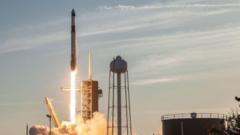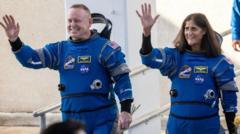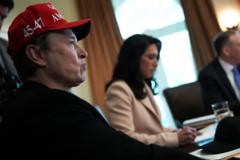**Description**
**Title**

**Title**
The Future of Space Exploration: Can AI Robots Outperform Human Astronauts?
With advancements in robotics and artificial intelligence, experts are debating whether human astronauts are still necessary for space exploration.
**Summary**
As autonomous spacecraft demonstrate remarkable capabilities, scientists ponder the role of human presence in space missions, weighing the benefits of robotic exploration against the inspiration and versatility that humans provide.
---
On Christmas Eve, NASA's Parker Solar Probe achieved a historic flyby of the Sun, marking a significant milestone in space exploration—one executed without any human intervention. The probe, utilizing advanced autonomous technology, undertook pre-programmed tasks during its journey, underscoring the potential for robots to undertake missions that humans alone could not achieve.
This success raises an important question: Are human astronauts becoming obsolete in the quest to explore deeper into space? With robotic probes having already reached numerous celestial bodies, there is a shifting opinion on the necessity of human involvement in such explorations.
Lord Martin Rees, the UK’s Astronomer Royal, argues that sending humans into space is increasingly unjustifiable when compared to the efficiency and cost-effectiveness of robotic missions. He suggests that human launches serve more as affluent adventures rather than essential scientific endeavors. Similarly, Andrew Coates from University College London supports the notion that robots could accomplish extensive tasks far beyond the reach of human astronauts, largely at a lower cost.
Despite advancements in robotics, some believe that the reasons for sending humans into space remain valid. Dr. Kelly Weinersmith emphasizes that while humans are more adaptable and responsive, they also face significant challenges, including nutrition and habitat maintenance in the extreme conditions of space. The disparity in speed between robotic rovers—such as those on Mars—and human capabilities is also raised, highlighting that the latter may still be more effective in certain tasks.
Technological advancements promise to enhance the potential for AI-operated systems to assist astronauts. Dr. Kiri Wagstaff, a planetary scientist, underscores that AI could alleviate astronauts from mundane tasks, allowing them to concentrate on critical research. However, current rovers are constrained in their processing power, restricting the implementation of advanced AI technologies, though improvements are expected.
NASA’s Valkyrie robot exemplifies efforts to create human-like machines capable of undertaking complex tasks in space, while also serving as complements to human explorers. This hybrid approach aims to maximize the benefits of both human ingenuity and robotic efficiency.
Moreover, the motivations behind human space travel often include the inspirational appeal to audiences on Earth. Leroy Chiao, a former astronaut, contends that humans resonate on a personal level in ways that machines cannot, igniting public interest and enthusiasm for space exploration.
As missions are devised to return humans to the Moon, including NASA's Artemis program and plans from SpaceX for Mars colonization, the discussion continues about the balance between robotic and human-led explorations. Experts like Dr. Weinersmith note the numerous unresolved challenges of human life on Mars, suggesting that significant technological and ethical questions need answers before venturing deeper into the cosmos.
In a future where humans and robots may work closely together—potentially even with humans augmented technologically—the journey into the universe promises to remain a continuously evolving intersection of human aspiration and robotic efficiency. As we stand on the brink of new possibilities, the role of humans in space exploration remains both necessary and uncertain.
**Summary**
As autonomous spacecraft demonstrate remarkable capabilities, scientists ponder the role of human presence in space missions, weighing the benefits of robotic exploration against the inspiration and versatility that humans provide.
---
On Christmas Eve, NASA's Parker Solar Probe achieved a historic flyby of the Sun, marking a significant milestone in space exploration—one executed without any human intervention. The probe, utilizing advanced autonomous technology, undertook pre-programmed tasks during its journey, underscoring the potential for robots to undertake missions that humans alone could not achieve.
This success raises an important question: Are human astronauts becoming obsolete in the quest to explore deeper into space? With robotic probes having already reached numerous celestial bodies, there is a shifting opinion on the necessity of human involvement in such explorations.
Lord Martin Rees, the UK’s Astronomer Royal, argues that sending humans into space is increasingly unjustifiable when compared to the efficiency and cost-effectiveness of robotic missions. He suggests that human launches serve more as affluent adventures rather than essential scientific endeavors. Similarly, Andrew Coates from University College London supports the notion that robots could accomplish extensive tasks far beyond the reach of human astronauts, largely at a lower cost.
Despite advancements in robotics, some believe that the reasons for sending humans into space remain valid. Dr. Kelly Weinersmith emphasizes that while humans are more adaptable and responsive, they also face significant challenges, including nutrition and habitat maintenance in the extreme conditions of space. The disparity in speed between robotic rovers—such as those on Mars—and human capabilities is also raised, highlighting that the latter may still be more effective in certain tasks.
Technological advancements promise to enhance the potential for AI-operated systems to assist astronauts. Dr. Kiri Wagstaff, a planetary scientist, underscores that AI could alleviate astronauts from mundane tasks, allowing them to concentrate on critical research. However, current rovers are constrained in their processing power, restricting the implementation of advanced AI technologies, though improvements are expected.
NASA’s Valkyrie robot exemplifies efforts to create human-like machines capable of undertaking complex tasks in space, while also serving as complements to human explorers. This hybrid approach aims to maximize the benefits of both human ingenuity and robotic efficiency.
Moreover, the motivations behind human space travel often include the inspirational appeal to audiences on Earth. Leroy Chiao, a former astronaut, contends that humans resonate on a personal level in ways that machines cannot, igniting public interest and enthusiasm for space exploration.
As missions are devised to return humans to the Moon, including NASA's Artemis program and plans from SpaceX for Mars colonization, the discussion continues about the balance between robotic and human-led explorations. Experts like Dr. Weinersmith note the numerous unresolved challenges of human life on Mars, suggesting that significant technological and ethical questions need answers before venturing deeper into the cosmos.
In a future where humans and robots may work closely together—potentially even with humans augmented technologically—the journey into the universe promises to remain a continuously evolving intersection of human aspiration and robotic efficiency. As we stand on the brink of new possibilities, the role of humans in space exploration remains both necessary and uncertain.


















